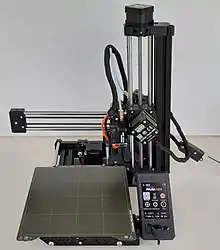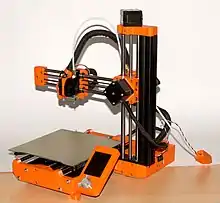 Prusa Mini+ Black Edition | |
| Classification | Fused deposition modeling 3D printer |
|---|---|
| Inventor | Josef Průša |
| Manufacturer | Prusa Research |
The Prusa Mini, sometimes stylized as the Original Prusa MINI, is an open-source fused deposition modeling 3D printer that is manufactured by the Czech company Prusa Research.[1][2] The printer is the lowest cost machine produced by Prusa Research and is designed as a first printer or as part of a 'print farm'.[1][3][4]
Specifications
Mini

The Prusa Mini was officially launched in October 2019.[5] The printer is available either assembled or as a kit. The build volume is 180 x 180 x 180 mm, and the print is performed on a spring steel sheet which meant to be easy to remove.[2] Minimum layer resolution is 50 micrometers, and the maximum travel speed is 200 millimeters per second. The printer has an LCD color display (non-touch), is able to print via USB drives. It has a custom 32-bit mainboard and a built-in online firmware updater. The printer has sensorless homing using Trinamic 2209 drivers and has a custom hot end which supports E3D nozzles.[6][7]
It has several safety features including three thermistors to detect thermal runaway.
Mini+
In November 2020, the Prusa Mini was replaced by the Mini+, which had a few small updates meant to ease assembly and maintenance.[8] One of the changes was a new mesh bed levelling sensor called "SuperPINDA" which replaced the previous "MINDA" sensor, and it is claimed by the manufacturer that this should result in a more consistent calibration of the first print layer in particular. The Mini+ filament sensor is an optional extra.
Upgrades
In September 2023, Prusa Research announced that upcoming Mini and Mini+ firmware would include network remote management using the PrusaConnect service, and input shaping for much faster printing with no physical changes to the printer needed.[9]
The printer is the first open source hardware product to require a user wishing to use unsigned firmware to physically break off a piece of the PCB, voiding the printer's warranty, before it can be flashed onto the board.[10] This is intended to reduce Prusa's liability should someone create custom firmware with potential to cause harm (such as disabling thermal runaway protections or other safety features).[10]
See also
References
- 1 2 Griffiths, Laura (24 October 2019). "Prusa introduces new $350 MINI 3D printer". TCT Magazine. Retrieved 26 December 2019.
- 1 2 "Prusa Unveils Original Prusa Mini 3D Printer and Announces Prusa XL". All3DP. 12 October 2019. Retrieved 26 December 2019.
- ↑ Bush, Steve (14 October 2019). "Prusa cuts the cost of production and prototype 3D printing". Electronics Weekly. Retrieved 26 December 2019.
- ↑ "Mini Prusa MK3 Appears at TCT Birmingham 2019". All3DP. 25 September 2019. Retrieved 26 December 2019.
- ↑ Prusa, Josef (12 October 2019). "Original Prusa MINI is here: Smart and compact 3D printer for everyone!".
- ↑ "2019 Original Prusa Mini 3D Printer: Review the Specs". All3DP. 14 October 2019. Retrieved 26 December 2019.
- ↑ "Prusa Research Releases Prusa Mini for $349". 3DPrint.com | The Voice of 3D Printing / Additive Manufacturing. 14 October 2019. Retrieved 26 December 2019.
- ↑ Prusa, Josef (24 November 2020). "November 2020 Update: Original Prusa i3 MK3S+ and MINI+ now shipping, MINI+ kit in the works, new steel sheet available".
- ↑ Kohut, Adam (20 September 2023). "Original Prusa MK4 Input Shaping Is Here, and the Mini Gets in on the Fun Too". All3dp. Retrieved 26 November 2023.
- 1 2 "Prusa Dares You To Break Their Latest Printer". Hackaday. 16 December 2019. Retrieved 26 December 2019.